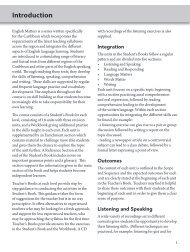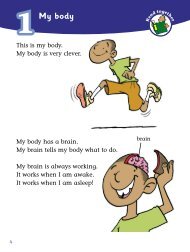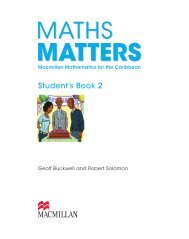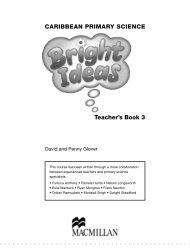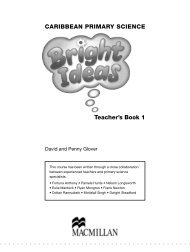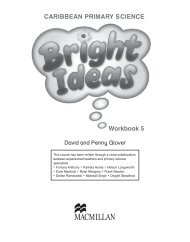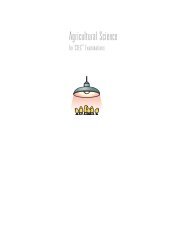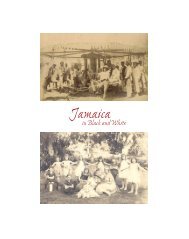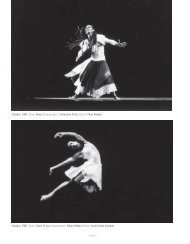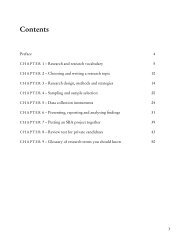Reading Skills - Macmillan Caribbean
Reading Skills - Macmillan Caribbean
Reading Skills - Macmillan Caribbean
You also want an ePaper? Increase the reach of your titles
YUMPU automatically turns print PDFs into web optimized ePapers that Google loves.
<strong>Reading</strong> <strong>Skills</strong>for 4 year oldsKaren Bryant-MoleSeries Consultant:Lead Advisor:Academic Advisor:Teacher Advisors:Dr Rebecca TortelloDr Rose DaviesWinnifred WhittakerCynthia CampbellKerese ChamberlainDanielle Griffiths-Chin9780230428867-READING4YRS_4pp.indd 1 22/11/2012 11:54
<strong>Macmillan</strong> EducationBetween Towns Road, Oxford, OX4 3PPA division of <strong>Macmillan</strong> Publishers LimitedCompanies and representatives throughout the worldwww.macmillan-caribbean.comISBN: 978-0-230-42886-7Text © Karen Bryant-Mole 2013Design and illustration © <strong>Macmillan</strong> Publishers Limited 2013First published in 2013All rights reserved; no part of this publication may bereproduced, stored in a retrieval system, transmitted in anyform or by any means, electronic, mechanical, photocopying,recording, or otherwise, without the prior written permissionof the publishers.These materials may contain links for third party websites. Wehave no control over, and are not responsible for, the contents ofsuch third party websites. Please use care when accessing them.Designed and typeset by Carol HulmeIllustrated by John HaslamCover design by John Haslam and <strong>Macmillan</strong> EducationCover illustration by John HaslamPrinted and bound in Malaysia2017 2016 2015 2014 201310 9 8 7 6 5 4 3 2 19780230428867-READING4YRS_4pp.indd 2 22/11/2012 11:54
Notes for Teachers and ParentsCurriculum LinksIt is recognised that the principal means of deliveringan Early Childhood curriculum should be through handsonactivities and experience-based learning. Theseworkbooks are therefore intended to support the deliveryof the curriculum rather than to be the main means ofdelivering it. The left-hand columns of the charts onpages 4 and 5 show how the pages in this workbookmap to the Jamaica Early Childhood Curriculum Guide.ApproachThis workbook is designed to help children develop the basicskills that will enable them to go on to become effective,confident readers. These skills include phonologicalawareness (which refers to a general awareness of soundin spoken words, for example an awareness that wordscan be broken up into individual syllables) and phonemicawareness (which refers specifically to an awareness ofthe individual sounds in spoken words). Research hasshown that a child’s level of phonological and phonemicawareness at the pre-reading stage is one of the bestindicators of early reading success.Phonemic AwarenessIn this workbook, each letter sound is usually introducedover a set of three pages. The first two of these pagescentre on enhancing phonemic awareness. On the firstpage, the children repeat a word that starts with thetarget sound and are encouraged to listen for and thenmake that sound. Images act as prompts to identify otherwords that start with the same sound. Provided it startswith the target sound, any word that is a reasonableinterpretation of the image should be accepted. Thesecond page invites the child to distinguish betweena word that starts with the target sound and one thatdoes not. Finally, a free activity allows the children todemonstrate their understanding by supplying their ownword that starts with the target sound. With all theseactivities, it is very important to use letter sounds ratherthan letter names. Where you see the symbol /s/, forexample, say ‘ss’ not ‘ess’. Note that the sound shown as/q/ should be pronounced /kw/ and the sound shown as/x/ should be pronounced /ks/.PhonicsPhonics instruction helps children learn how the soundsof spoken language correspond to the letters of writtenlanguage. The last of each set of letter sound pages helpschildren recognise this relationship between the spokensound and the written letter by inviting them to make thesound and showing them the letter in both its commonand capital forms. The final exercise encourages childrento notice that if a whole word starts with a particularsound when spoken, it will probably start with theassociated letter when written. When children start tolearn to read, they come across many new and unknownwords. Looking at the initial letter of the word will givethem a clue as to the initial sound of the word and helpthem to make sensible guesses about what the newword might be.Learning OutcomesThe outcomes shown at the foot of each page indicatethe learning point that is the focus of the activitieson that page. On pages 94 and 95 you will find anOutcomes Checklist. This checklist facilitates themonitoring of each individual child’s progress. Teachersare encouraged to tick and date an outcome only whenit has been achieved. If a child has not successfullymastered the relevant skill, teachers should make anote of this in the Comments/Observations column andprovide extra practice until they are satisfied that thedesired outcome has been attained. Parents can usethe Outcomes Checklist to keep themselves informedof their child’s achievements.Extension ActivitiesYou are encouraged to use the exercises in the workbookas a springboard for extension questions and as aprompt for discussions that lead to vocabulary buildingand critical and creative thinking. The ‘talking teacher’character in this workbook gives some examples of waysin which this can be achieved. Further ideas for activitiescan be found on page 96. Many of the activities can beused in class when children finish tasks early, or at hometo reinforce the skills being learned in school.Learning outcome: Child practises reading words and sentences with B and b. 39780230428867-READING4YRS_4pp.indd 3 22/11/2012 11:54
Contentswith links to the Jamaica Early Childhood Curriculum Guide and<strong>Macmillan</strong> Early Birds Writing <strong>Skills</strong> for 4 year oldsCurriculumGuide<strong>Macmillan</strong> Early Birds<strong>Reading</strong> <strong>Skills</strong>PageCelebrating Mepp7/8 Names: long and short 6Names: own name 7Sounds: /l/ 8Words: /l/ 9Letters: l and L 10pp9/10 Sounds: /t/ 11Words: /t/ 12Letters: t and T 13pp15/16 Sounds: /f/ 14Words: /f/ 15Letters: f and F 16pp17/18 Sounds: /h/ 17Words: /h/ 18Letters: h and H 19pp23/24 Review: letters l, L, t, T, f, F, h, H 20pp25/26 Review: sounds /l/, /t/, /f/, /h/ 21Sounds: /a/ 22Words: /a/ 23Letters: a and A 24Celebrationspp31/32 Sounds: /d/ 25Words: /d/ 26Letters: d and D 27Words: different 28Words: same 29pp33/34 Sounds: final /x/ 30Letters: x and X 31Syllables: names 32pp35/36 Syllables: words 33pp37/38 Sounds: /r/ 34Words: /r/ 35Letters: r and R 36pp39/40 Sounds: /c/ 37Words: /c/ 38Letters: c and C 39pp41/42 Sounds: /n/ 40Words: /n/ 41Letters: n and N 42pp49/50 Sounds: /i/ 43Words: /i/ 44Letters: i and I 45pp51/52 Review: /a/, /r/, /c/, /h/, /t/ 46Review: /d/, /n/, /i/, /f/, /l/ 47<strong>Macmillan</strong> Early BirdsWriting <strong>Skills</strong>PageCelebrating MeLetter Strokes: straight lines 6Letter Strokes: curved lines 7Common Letters: l 8Capital Letters: L 9Numerals: 1 10Numerals: 2 11Common Letters: t 12Capital Letters: T 13Numerals: 3 14Numerals: 4 15Common Letters: f 16Capital Letters: F 17Numerals: 5 18Numerals: 6 19Common Letters: h 20Capital Letters: H 21Review: l, t, f, h 22Review: L, T, F H 23Common Letters: a 24Capital Letters: A 25CelebrationsCommon Letters: d 26Capital Letters: D 27Numerals: 7 28Numerals: 8 29Common Letters: x 30Capital Letters: X 31Numerals: 9 32Numerals: 0 33Common Letters: r 34Capital Letters: R 35Common Letters: c 36Capital Letters: C 37Common Letters: n 38Capital Letters: N 39Common Letters: i 40Capital Letters: I 41Review: a, d, x, r, c, n, i 42Review: A, D, X, R, C, N, I 434Learning outcome: Child.9780230428867-READING4YRS_4pp.indd 4 22/11/2012 11:54
CurriculumGuide<strong>Macmillan</strong> Early Birds<strong>Reading</strong> <strong>Skills</strong>PagePlantspp59/60 Sounds: /s/ 48Words: /s/ 49Letters: s and S 50pp63/64 Sounds: /m/ 51Words: /m/ 52Letters: m and M 53pp67/68 Sounds: /q/ 54Letters: q and Q 55pp69/70 Sounds: /b/ 56Words: /b/ 57Letters: b and B 58pp71/72 Sounds: /j/ 59Words: /j/ 60Letters: j and J 61pp77/78 Sounds: /o/ 62Words: /o/ 63Letters: o and O 64Transportationpp79/80 Sounds: /e/ 65Letters: e and E 66pp81/82 Sounds: /v/ 67Words: /v/ 68Letters: v and V 69pp83/84 Sounds: /p/ 70Words: /p/ 71Letters: p and P 72pp85/86 Sounds: /k/ 73Words: /k/ 74Letters: k and K 75pp89/90 Sounds: /w/ 76Words: /w/ 77Letters: w and W 78People in Our Communitypp99/100 Sounds: /g/ 79Words: /g/ 80Letters: g and G 81pp103/104 Sounds: /y/ 82Words: /y/ 83Letters: y and Y 84pp107/108 Sounds: /z/ 85Words: /z/ 86Letters: z and Z 87pp111/112 Sounds: /u/* 88Letters: u and U* 89Review: /f/ /j/ /t/ /u/ /b/ /p/ 90pp115/116 Review: /n/ /h/ /m/ /r/ /e/ /s/ 91pp117/118 Review: /d//a/ /c/ /g/ /o/ /q/ 92Review: /i/ /k/ /l/ /v/ /w/ /x/ /y/ /z/ 93Outcomes Checklist 94Ideas 96<strong>Macmillan</strong> Early BirdsWriting <strong>Skills</strong>PagePlantsCommon Letters: s 44Capital Letters: S 45Common Letters: m 46Capital Letters: M 47Common Letters: q 48Capital Letters: Q 49Common Letters: b 50Capital Letters: B 51Words: bin, hat 52Words: lid, fan 53Common Letters: j 54Capital Letters: J 55Common Letters: o 56Capital Letters: O 57TransportationCommon Letters: e 58Capital Letters: E 59Common Letters: v 60Capital Letters: V 61Words: red, van 62Words: cat, six 63Common Letters: p 64Capital Letters: P 65Common Letters: k 66Capital Letters: K 67Common Letters: w 68Capital Letters: W 69People in Our CommunityCommon Letters: g 70Capital Letters: G 71Words: jet, dog 72Words: ink, map 73Common Letters: y 74Capital Letters: Y 75Common Letters: z 76Capital Letters: Z 77Common Letters: u* 78Capital Letters: U* 79Review: fF, jJ, tT, uU, bB, pP 80Review: nN, hH, mM, rR, eE, sS 81Review: dD, aA, cC, gG, oO, qQ 82Review: iI, lL, vV, wW, xX, yY, kK, zZ 83Letter Formation Guide 84Outcomes Checklist 86Ideas 88* The sound /u/ and the letters u and U are not specified in the Curriculum Guide but are included here to ensure comprehensive coverage of the alphabet.59780230428867-READING4YRS_4pp.indd 5 22/11/2012 11:54
Names: long and shortLook at these names. Names can look long or short. They can also sound long or short.Listen to your teacher read each name. Say if it sounds long or short.SamStephanieJuneLeonardoTomNames that look long often sound long. Names that look short often sound short.Does your name look long or short? Does your name sound long or short?6Learning outcome: Child can identify long and short names.9780230428867-READING4YRS_4pp.indd 6 22/11/2012 11:54
Names: own name1. Each of these pegs has a label with a child’s name.Listen to your teacher read the names.DanielBriannaRicardo GabrielleIs your name the same as one of these names or is it different?2. Your teacher will write your name on one label and a different name on theother label.Which one is your name?Colour the schoolbag under your name red.Colour the schoolbag under the other name yellow.Learning outcome: Child can recognise his or her printed name.79780230428867-READING4YRS_4pp.indd 7 22/11/2012 11:54
Sounds: /l/1. This picture shows a lion. Say lion.Can you hear the sound /l/ at the beginning of lion?Can you make the sound /l/? Say /l/, /l/, /l/, /l/.2. Look at the pictures. Say what they show.All the words begin with the sound /l/.Think carefully. The name of the object must begin with the sound /l/.8 Learning outcome: Child can make and identify the sound /l/.9780230428867-READING4YRS_4pp.indd 8 22/11/2012 11:54



